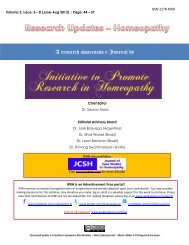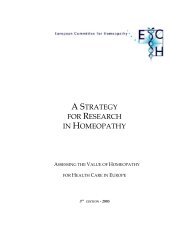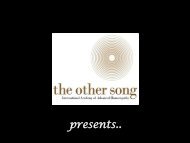Clinical Verification - European Committee for Homeopathy
Clinical Verification - European Committee for Homeopathy
Clinical Verification - European Committee for Homeopathy
- No tags were found...
Create successful ePaper yourself
Turn your PDF publications into a flip-book with our unique Google optimized e-Paper software.
<strong>Clinical</strong> <strong>Verification</strong> ofSymptom Pictures ofHomeopathic MedicinesA Proposal <strong>for</strong>An International Standard
- <strong>Clinical</strong> verification of symptom pictures of homeopathic medicines -AuthorsS Fayeton and M van Wassenhoven <strong>for</strong> Working Group ‘<strong>Clinical</strong> <strong>Verification</strong> of Symptoms’SummaryThis invitation <strong>for</strong> co-operation is addressed to all interested groups. Its purpose is datacollection <strong>for</strong> clinical verification of symptoms from homeopathic proving and collection ofclinical symptoms not derived from homeopathic pathogenetic trials (provings). To date noconsensus exists on this topic. The <strong>European</strong> <strong>Committee</strong> <strong>for</strong> <strong>Homeopathy</strong> (ECH) research subcommitteehas created a working group on this topic. This paper is the result of a review ofpapers on the topic, exchanges between members and a meeting.Introduction<strong>Homeopathy</strong> is a system of medicine including different concepts of treatment (global similitude,clinical similitude, isopathy, etc.), all these aspects must be taken into consideration. Systematicclinical data collection must match contemporary reality as a whole. The aim of this proposal is topromote convergence, allowing the use of a common language between different kinds ofhomeopathic practice. The proposed data collection system is flexible and accessible manually or byin<strong>for</strong>mation technology. The ultimate objective of this proposal is to develop an in<strong>for</strong>mation systemallowing collection, recording, extraction, processing, interpretation, evaluation and communication.The aim of this paper is to create the initial conditions <strong>for</strong> clinical data collection, later allowing theverification of remedy provings as well as clinical symptoms, which do not originate frompathogenetic trials (provings). <strong>Clinical</strong> data collection and classification systems must respect the‘spirit’ of homeopathic practice.ProposalThis proposal is intended to be used by all interested groups. Its purpose is data collection <strong>for</strong> clinicalverification of homeopathic proving and a collection of clinical symptoms, which have not beenobserved in homeopathic pathogenetic trials (HPTs, provings).Phase IFollowing a decision to collect and analyse clinical data related to one homeopathic medicine (to bespecified). The factors listed below will be described as completely as possible from the literature andexisting knowledge of the remedy:• Listing, study and analysis of existing homeopathic proving(s) of the medicine concerned.• Classification of symptoms:Al generated by toxicological studies;A2 described by sensitive prover(s);B 1 clinical or local symptom(s);B2 chronic symptom(s).• Symptom evaluation:Vi number of provers (validated symptom);V2 accuracy of symptom’s description;V3 unknown or unspecified.2
- <strong>Clinical</strong> verification of symptom pictures of homeopathic medicines -• Grouping of symptoms:Gi anatomic systems (Kent);G2 meaning (essence — spirit — remedy problem).• Stages (dynamic of the remedy).The results of phase I will be circulated to all candidates/contributors, together with a call <strong>for</strong> clinicaldata collection on this medicine.Phase II<strong>Clinical</strong> data collectionGiven the level of accuracy needed <strong>for</strong> clinical data collection required <strong>for</strong> the verification ofhomeopathic remedy proving and a collection of clinical symptoms not deriving from HPTs, it wouldbe better to organise such data collection separately from data collection aimed at analysis of theeffectiveness of homeopathic treatments <strong>for</strong> specified diagnoses.Essential elements are:• Age and sex of the patient.• The medicine concerned must have been prescribed as a single remedy (unitary homeopathy).No other homeopathic medicine can be taken within at least one month be<strong>for</strong>e reporting of thecure.• In case of possible doubt, reasons <strong>for</strong> acceptance must be justified. All possible concomitantsmust be mentioned (allopathy, psychotherapy, etc.) and in these cases, reports must beaccompanied by a detailed description of the interventions (substance, dose, usage time (and/orperiod), timing).Since this data collection is focused on cases which have responded to homeopathic treatment, thelevel of response should be specified:• only one or a few symptoms;• syndrome;• general improvement (local and general symptoms including general well being);• global (physical, general and mind);• behavioural (the global effect is accompanied with positive changes in behaviour).The reasons <strong>for</strong> the initial choice of the medicine will be described: examples: keynote(s):• aetiologic circumstances;• clinical indications;• global or mind oriented repertorisation;• ‘meaning’ of patient’s problems (essence, spirit, remedy problem).More than one reason is possible <strong>for</strong> a case.Details of the symptom(s) and its disappearance should be recorded, including:• timing (histopathography);• recurrence(s);• results of a second prescription;• confirmation(s) by other case(s).For more than one symptom, each of the above should be described as well as the general level of3
- <strong>Clinical</strong> verification of symptom pictures of homeopathic medicines -health.When symptom(s) appear during treatment, the following should be specified. Is this:• a recurrence of old symptom(s)?• new symptom(s)?• notable features?Phase IIIAnalysis of data by the organisers of the data collectionSymptoms collected will be classified in accordance with following criteria:(a) Factual: symptom originality; modalities and level of detail; global view of the patient:actuality (recent symptom) or anteriority (persistent old symptom); verification of proving orsymptom not described in previous published provings or clinical symptoms.(b) Anatomically.(c) Keywords: <strong>for</strong> later comparison of gathered symptoms with each other.(d) Two separate lists will be generated <strong>for</strong> verified old and new symptoms.(e) Grouping: symptoms will be grouped together in different sets, possible links betweendifferent symptoms are checked(f) Meaning: looking at these ‘sets of symptoms’ possible remedy ‘picture(s)’ could be proposed,a new framework of understanding <strong>for</strong> the remedy could emerge from this analysis.(g) Evaluation: especially <strong>for</strong> new symptoms, the value of the symptom would be scrutinised (frequencyof occurrence—accuracy) be<strong>for</strong>e possible inclusion within the framework ofknowledge of the remedy.Finally, a new presentation of the remedy under analysis will be proposed to the homeopathic community.New questions about the remedy could be proposed <strong>for</strong> a further round of data collection andanalysis.ReferencesVan Haselen R, Fisher P. Describing and improving homeopathy—use of systematic data collection. Br Hom J 1994; 83:135—141.Fayeton S. Confirmation Clinique du Remède Jacaranda. AFADH meeting report, Lyon: France, 26 February 1999.Steinsbeldc A. Data collection in homeopathic practice—A suggestion <strong>for</strong> an international standard Br Hom J 2000; 89(Suppl 1) : S39.Fayeton S. Confirmation Clinique du Remade Vipera. AFADH meeting report presented at the general assembly of ECH,Brussels, Belgium, October 1998.Fichefet J. Processing the In<strong>for</strong>mation in <strong>Homeopathy</strong>— The Importance of Medical Decision Aid and Theory of Chaos.Report presented at the general assembly of ECH, Brussels, Belgium, October 1998.Biolchini J. HOMIS—User study in homeopathic clinical practice: a fundamental tool <strong>for</strong> designing and improving a clinicalin<strong>for</strong>mation system. Br Hom J 2000; 89 (Suppl 1): S40.Rezzani CM. Winchip: computerised homeopathic investigation program: a data collection tool to help the doctor in dailypractice to prove and improve homeopathy. Br Hom J 2000; 89 (Suppl 1): S41.4
- <strong>Clinical</strong> verification of symptom pictures of homeopathic medicines -Appendix 1Declaration of IntentName of organising group:Address:Our group intends to organise systematic data collection <strong>for</strong> clinical verification of:Remedy:If you are interested in collaboration, please ask us <strong>for</strong> the overview about the current knowledge onthis remedy.I am interested:Name:Address:Phone/fax:E-mail:5
- <strong>Clinical</strong> verification of symptom pictures of homeopathic medicines -Appendix 2Systematic clinical data collection <strong>for</strong>mRemedyCodePatient sexBirthday or ageConcomitantsCuring level:…………………………………………….:…………………………………………….:…………………………………………….:…………………………………………….:…………………………………………….:………………………………………………………………………………………………………………………………………………………………: ■ Symptom ■ Syndrome ■ General■ Global■ BehaviourExplanation or comments:………………………………………………………………………………………………………………………………………………………………………………………………………………………………………………………………………………………………………………………………………………………………………Prescription purpose:■ Keynote(s): …………………………………………………………………………………………………………………………………………■ Repertorisation■ Etiologic■ <strong>Clinical</strong>■ Global■ Mind■ Other(s) …………………………………………………………………………………………………………………………■ Materia Medica …………………………………………………………………………………………………………………………………■ Directly■ Confirmation of repertory■ Remedy Meaning (essence—spirit—remedy problem)■ Other …………………………………………………………………………………………………………………………………………………………………………………………………………………Explanation or comments: …………………………………………………………………………………………………………………………………………………………………………………………………………………………………………………………………………………………………………………………………………………………………SYMPTOM number : …………SYMPTOM description : ……………………………………………………………………………………………………………………………………………………………………………………………………………………………………………………………………………………………………………………6
- <strong>Clinical</strong> verification of symptom pictures of homeopathic medicines -HistopathographyTime period <strong>for</strong> symptom disappearance : …………………………………………………Possible recurrence(s) : ………………………………………………………………………………………………………………………………………………………Result of second prescription : ………………………………………………………………………………………………………………………………………………………Type■ known (mentioned in the remedy overview, pp ……………………………………………….)■ known (personal source:………………………………………………………………………..)■ new (not yet known within previous published provings or clinical drug feature)■ confirmed by other personal cases (how many?………………………………………………..)■ appearance during treatment■ old (Hering)■ new (<strong>for</strong> the patient)Frame■ isolated■ part of a set of symptoms (please list) 1with other significant resultscomments: ………………………………………………………………………………………………………………………………………………………………………………………………………■ general (all local symptoms together)■ global (well being)■ behaviouralComments……………………………………………………………………………………………………………………………………………………………………………………………………………………………………………………………………………………………………………………………………………………………………………………………………………………………………………………………………………………………………………………………………………………1 Don’t <strong>for</strong>get to add a global list with all collected symptoom <strong>for</strong> the patient and your general comments (including possiblelink between symptoom - picture of the remedy - ‘meaning’)7










